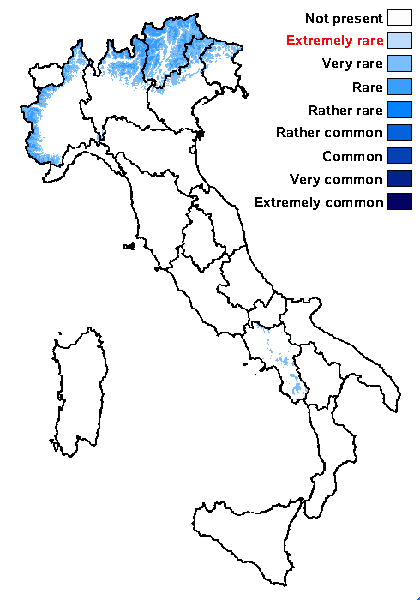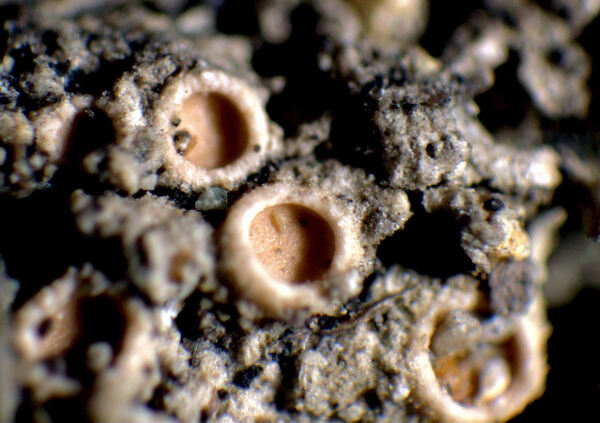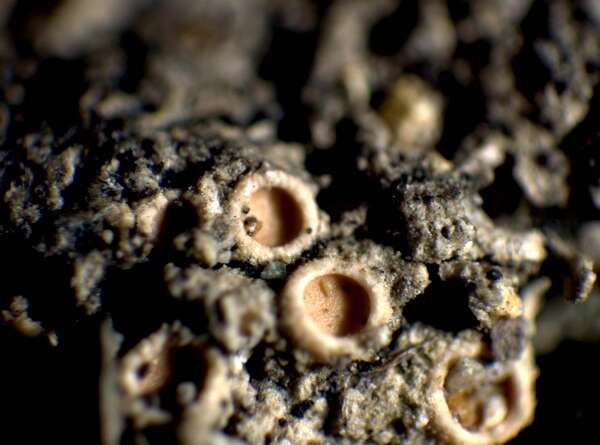Gyalecta geoica (Ach.) Ach.
K. Vetensk.-Akad. Nya Handl., 29: 229, 1808. Basionym: Urceolaria geoica Wahlenb. ex Ach. - Meth. Lich.: 149, 1803.
Synonyms: Secoliga geoica (Ach.) Körb.
Distribution: N - Frl, Ven (Nascimbene 2003b, Tomaselli & al. 2006), TAA (Nascimbene 2003, 2008b, Nascimbene & al. 2004, 2004b), Lomb, Piem (TSB 34069). S - Camp.
Description: Thallus crustose, episubstratic, whitish or yellowish white, very thin, more or less continuous, sometimes granulose-farinose, often inapparent. Apothecia without a thalline margin (but often covered at the base by a thin thalline layer when young), semi-immersed, not constricted at base, (0.2-)0.3-0.5(-0.6) mm across, with a yellowish to orange-brown, concave to flat disc and a thick, raised, more or less pink-coloured, paler proper margin. Proper exciple prosoplectenchymatous; epithecium colourless to pale yellowish brown; hymenium colourless, 80-110 µm high, the hymenial gel I+ blue; paraphyses simple to sparingly branched, c. 1.5 µm thick at mid-level, the apical cells to 3 µm wide; hypothecium colourless or pale yellowish brown. Asci 8-spored, cylindrical to elongate-subclavate, thin-walled, without tholus, the tip drawn out into a conical point, the wall K/I+ blue. Ascospores 3-septate, with at least one septum not parallel with the others, hyaline, narrowly ellipsoid, (9-)10-16(-18) x 4-7 µm. Photobiont trentepohlioid. Spot tests: K-, C-, KC-, P-, UV-. Chemistry: without lichen substances.Note: a cool-temperate to arctic-alpine, circumpolar species found on soil, bryophytes and plant debris over calcareous or basic siliceous substrata, often in rock fissures in sheltered situations, mostly in upland areas.
Growth form: Crustose
Substrata: soil, terricolous mosses, and plant debris
Photobiont: Trentepohlia
Reproductive strategy: mainly sexual
Commonnes-rarity: (info)
Alpine belt: rare
Subalpine belt: very rare
Oromediterranean belt: extremely rare
Montane belt: very rare
Submediterranean belt: absent
Padanian area: absent
Humid submediterranean belt: absent
Humid mediterranean belt: absent
Dry mediterranean belt: absent

Predictive model
Herbarium samples
Growth form: Crustose
Substrata: soil, terricolous mosses, and plant debris
Photobiont: Trentepohlia
Reproductive strategy: mainly sexual
Commonnes-rarity: (info)
Alpine belt: rare
Subalpine belt: very rare
Oromediterranean belt: extremely rare
Montane belt: very rare
Submediterranean belt: absent
Padanian area: absent
Humid submediterranean belt: absent
Humid mediterranean belt: absent
Dry mediterranean belt: absent

Predictive model
| Herbarium samples |
 Index Fungorum
Index Fungorum
 GBIF
GBIF




